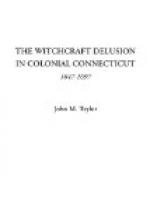In the publication of Grant’s note Miss Trumbull has rendered a great service in the settlement of a disputed question, in the correction of errors, in fixing the priority of the outbreak between Massachusetts and Connecticut; and in the new light shining through this revelation stands Alse, glorified with the qualities of youth, of gentleness, of innocence; and the story of her going to the unholy sacrifice on that fateful May morning more than two and a half centuries ago is told with exquisite tenderness and pathos.
Confirmation of the truth of Grant’s entry is given by the scholarly historian of Windsor, Dr. Stiles, who says in his history of that ancient town:
“We know that a John Youngs, [?] bought land in Windsor of William Hubbard in 1641—which he sold in 1649—and thereafter disappears from record. He may have been the husband or father of ’Achsah’[?] the witch; if so, it would be most natural that he and his family should leave Windsor.” STILES’ History of Windsor (pp. 444-450).
JOHN and JOAN CARRINGTON. Wethersfield, 1651.
They were indicted at a court held February 20, 1651, Governor John Haynes and Edward Hopkins being present, with other magistrates; and they were found guilty on March 6, 1651. Both were executed. Records Particular Court (2: 17). [Dr. Hoadley’s note in this case: “Mr. Trumbull (Dr. J. Hammond Trumbull) told me he had a record of execution in these cases. I suppose he referred to the diary of Matthew Grant.”] The entry of the execution appears in Grant’s Diary, after the note as to Alse Young. One Blank of Windsor, TRUMBULL.
LYDIA GILBERT. Windsor, 1654.
October 3, 1651, Henry Stiles of Windsor was killed by the accidental discharge of a gun in the hands of Thomas Allyn, also of Windsor. An inquest was held, and Thomas was indicted in the following December. He plead guilty, and at the trial the jury found the fact to be “homicide by misadventure.” Thomas was fined L20 for his “sinful neglect and careless carriage,” and put under a bond of L10, for good behavior for a year. Records Particular Court (2: 29-57).
But witchcraft was abroad, and its tools and emissaries more than two years afterwards fastened suspicion of this death by clear accident, on Lydia Gilbert, it being charged that “thou hast of late years, or still dost give entertainment to Sathan ... and by his helpe hast killed the body of Henry Styles, besides other witchcrafts.”
She was indicted and tried in September or November, 1654, and “Ye party above mentioned is found guilty of witchcraft by ye jury.” Her fate is not written in any known record, but the late Honorable S.O. Griswold, a recognized authority on early colonial history in Windsor, says that as the result of a close examination of the record, “I think the reasonable probability is that she was hanged.” Records Particular Court (2: 51); STILE’S History of Windsor (pp. 169, 444-450).




